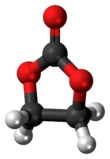Ethylene carbonate
| |||
| Names | |||
|---|---|---|---|
| IUPAC name
1,3-dioxolan-2-one | |||
| Other names
ethylene glycol carbonate[1] | |||
| Identifiers | |||
| 96-49-1 | |||
| 3D model (Jmol) | Interactive image | ||
| ChemSpider | 7030 | ||
| ECHA InfoCard | 100.002.283 | ||
| PubChem | 7303 | ||
| |||
| |||
| Properties | |||
| C3H4O3 | |||
| Molar mass | 88.06 g·mol−1 | ||
| Appearance | White to yellow solid | ||
| Density | 1.3210 g/cm3 | ||
| Melting point | 34 to 37 °C (93 to 99 °F; 307 to 310 K) | ||
| Boiling point | 243.0 °C (469.4 °F; 516.1 K) | ||
| Soluble | |||
| Hazards | |||
| Safety data sheet | External MSDS | ||
| EU classification (DSD) |
Irritant (XI) | ||
| R-phrases | R41 | ||
| S-phrases | S26 S39 | ||
| Flash point | 150 °C (302 °F; 423 K) | ||
| 465 °C (869 °F; 738 K) | |||
| Except where otherwise noted, data are given for materials in their standard state (at 25 °C [77 °F], 100 kPa). | |||
| | |||
| Infobox references | |||
Ethylene carbonate is the organic compound with the formula (CH2O)2CO. It is classified as the carbonate ester of ethylene glycol and carbonic acid. At room temperature (25 °C) ethylene carbonate is a transparent crystalline solid, practically odorless and colorless, and somewhat soluble in water. In the liquid state (m.p. 34-37 °C) it is a colorless odorless liquid.[2]
Production and reactions
Ethylene carbonate is produced by the reaction between ethylene oxide and carbon dioxide. The reaction is catalyzed by a variety of cations and complexes:[3]
- (CH2)2O + CO2 → (CH2O)2CO
Ethylene carbonate (and propylene carbonate) may be converted to dimethyl carbonate (a useful solvent and a mild methylating agent) via transesterification by methanol:
- C2H4CO3 + 2 CH3OH → CH3OCO2CH3 + HOC2H4OH
Dimethyl carbonate may itself be similarly transesterified to diphenyl carbonate, a phosgene-substitute:[3]
- CH3OCO2CH3 + 2 PhOH → PhOCO2Ph + 2 MeOH
Applications
Ethylene carbonate is used as a polar solvent with a molecular dipole moment of 4.9 D,[4][5] only 0.1 D lower than that of propylene carbonate. It can be used as a high permittivity component of electrolytes in lithium batteries.
Ethylene carbonate is also used as plasticizer, and as a precursor to vinylene carbonate, which is used in polymers and in organic synthesis.
See also
External links
References
- ↑ "CID 7303 -- PubChem Compound Summary". pubchem.ncbi.nlm.nih.gov. Retrieved 2008-03-15.
- ↑ JEFFSOL ETHYLENE CARBONATE catalog entry at www.huntsman.com. Accessed on 2010-02-18.
- 1 2 Hans-Josef Buysch (2005), "Carbonic Esters", Ullmann's Encyclopedia of Industrial Chemistry, Weinheim: Wiley-VCH, doi:10.1002/14356007.a05_197
- ↑ Ralph P. Seward; Ernest C. Vieira (1958). "The Dielectric Constants of Ethylene Carbonate and of Solutions of Ethylene Carbonate in Water, Methanol, Benzene and Propylene Carbonate". J. Phys. Chem. 62 (1): 127–128. doi:10.1021/j150559a041.
- ↑ Richard Payne; Ignatius E. Theodorou (1972). "Dielectric properties and relaxation in ethylene carbonate and propylene carbonate". J. Phys. Chem. 76 (20): 2892–2900. doi:10.1021/j100664a019.

